Abstract
This study aimed to present the criteria for the collision avoidance of maritime autonomous surface ships (MASS) in restricted areas. The criteria were presented via ship domains, and a seafarers’ awareness-based ship domain (SASD) that dynamically changes the existing SASD according to the external environment was used to develop a new domain model. For application, we have converged an adaptive neuro-fuzzy inference system with the existing model. The proposed SASD was applied to an actual marine restricted area and compared with automatic identification system (AIS) based ship domain models. Consequently, although there was a slight difference depending on the restricted area and domain design method applied, the SASD, (i.e., the minor axis of the elliptical domain) and the AIS-based ship domain were similar. Cross-validation of the seafarers’ awareness-based ship domain and the AIS-based ship domain could propose a reference lateral side passing distance for MASS in restricted areas. However, the major axis of the ellipse should be further studied since the domain design method differs between models.
1. Introduction
With the advent of the Fourth Industrial Revolution, the marine industry has been conducting research on maritime autonomous surface ship (MASS) [1]. Although research focuses mainly on developing a practical algorithm for fully MASS [2], to date, few large ships have been operated by artificial intelligence technology, and most remain under human control. This is because the technology of MASS has not been fully verified, and there are also limitations to overcome, such as the revision of regulations related to MASS [3]. In particular, MASSs have not sailed in restricted areas with heavy sea traffic, such as the Singapore Strait. In other words, under the current technology, humans have been more widely verified than artificial intelligence as a means of sailing large ships.
The continuous research on the risk of ship collisions has decreased the frequency of such accidents, although they still occur [4,5]. Since ship collision accidents can lead to sinking, oil spills, fires, or casualties, research to prevent such collisions is very important [6]. Consequently, research is being conducted on improving MASS [7]. To reduce ship collisions, the risk assessment of collisions between own ship (OS) and target ship (TS) has been studied in different ways [8]. Some researchers have performed scientific analyses using the closest point of approach and bow crossing range of two ships [9], while some have applied and schematized the general concept of the ship domain [10]. Therefore, this study presents the criteria for the collision avoidance of MASS using the ship domain.
Since the ship domain was first presented by [11], several ship domain models have been presented along with various research methods [12,13,14]. Ship domains are utilized for marine safety, evaluating the risk of collision between ships and diagnosing the suitability of sea channels [15,16]. Further, as the ship domain can be the basis for determining the avoidance action of MASS, its importance may increase [17] as follows.
When a MASS is avoiding a TS, a decision-making criterion is required [18]. The collision evaluation can be performed in terms of the distance between two ships and time. A typical method based on the distance factor in ship collision evaluation is the ship domain [19]. The ship domain is created as a safe area around the OS based on the safe distance. Therefore, the OS takes necessary actions to prevent itself from entering the TS domain. Collision-avoidance studies of MASS were normally based on the ship domain [18]. Therefore, the design of the ship domain may affect the collision-avoidance action of the MASS.
Recently, some artificial intelligence models have learned human behaviors and subsequently surpassed human abilities [20], e.g., AlphaGo. Therefore, ship domain studies should also propose models that learn human behaviors, although these kinds of ship domain models are rare. Ship domain models that have been presented to date can be classified according to the research method as follows.
The first model is a statistical ship domain based on ships’ navigational data. The statistical model was based on the ship’s navigational data using radar. Since then, an automatic identification system (AIS) has been used to present statistics-based ship domains based on a ship’s navigational data [21,22,23,24]. However, the disadvantage of this model is that it is based on ships’ passage in certain areas to which it is applied, so the AIS-based ship domain model may be difficult to apply to other specific areas.
Additionally, AIS data includes situations that the OS intended or OS unintended. For example, although the OS’s intention was to maintain a 1 NM (nautical mile) distance from the TS, the data may also include the record of the OS sailing while maintaining a 0.5 NM distance from the TS because of the traffic volume in restricted areas.
Second, reference [25] presented a mathematical ship domain model based on ships’ parameters and maneuverability. The presented model differs from the existing domain by its division into blocking and watching areas. Reference [26] used engineering calculations as a basis for their model. However, the presented mathematical model cannot reflect the sea conditions of navigating ships [27].
Finally, there are artificial intelligence models. The artificial intelligence-based domain model that uses fuzzy logic was first presented by [28]. In that model, the size of the ship domain changes dynamically according to the evaluation of a collision risk via fuzzy logic. However, the presented fuzzy domain is limited in that human elements and sea conditions are not considered [27].
The above-mentioned ship domain models are classified into three categories. However, the disadvantage of the presented models is that they do not directly reflect the intention of the ship’s operators. To compensate, [29] presented a domain model that reflects seafarers’ awareness of safe distance; they claimed that a ship domain model reflecting human awareness is required because artificial intelligence surpasses human ability once that ability has been learned.
Artificial intelligence has demonstrated the learning of human patterns and the surpassing of human abilities in games with simple rules, such as Go and chess [30,31]. However, operating a ship is different from the rules of Go or chess. The International Regulations for Preventing Collisions at Sea (COLREGS) contain rules that cannot be presented simply, clearly, and quantitatively, as in Go and chess. These regulations involve qualitative evaluation [32]; therefore, there are many ambiguous elements involved when artificial intelligence learns COLREGS on its own. For example, in terms of a summary of the safe speed in Rule 6 of COLREGS, it is stated that “Every vessel shall at all times proceed at a safe speed so that she can take proper and effective action to avoid collision and be stopped within a distance appropriate to the prevailing circumstances and conditions”.
However, interpreting when to do this will be at the discretion of the seafarers who maneuver the ship. It was attempted to conduct research using an engineering approach to present these safe distance criteria. Reference [29] presented a domain model based on the value of the safe distance of seafarers’ awareness, which differed from the methods presented so far. According to this study, a safe distance was defined as the distance of the closest point of approach (DCPA) value to the TS is large enough not to take an avoidance action, but the DCPA value is not small enough, so one should be cautious. However, the presented model simply presented the domain via seafarers’ awareness values and did not consider sea conditions. According to [29], seafarers’ awareness values can be changed by the external environment in restricted areas. Therefore, the present study demonstrates a ship domain model in restricted areas that considers sea conditions.
Considering all possible sea conditions in restricted areas would be difficult. However, a ship domain model should be designed in such a way that it precisely reflects seafarers’ awareness. This study identified the major influential factors in changing seafarers’ awareness values when navigating restricted areas via discussions with experts. Furthermore, the degree of change in seafarers’ awareness values according to the identified factors was established by experts.
To present a domain model based on seafarers’ awareness values that consider the sea conditions in restricted areas, the present study used an adaptive neuro-fuzzy inference system (ANFIS), which is an artificial intelligence model that combines fuzzy logic and artificial neural networks (ANNs). ANNs have the ability to learn, which complements the ambiguity of fuzzy logic and its ability to explain dynamic characteristics [33].
2. Methodology
2.1. Overview
This study proposes seafarers’ awareness-based ship domain (SASD) reflecting the sea conditions in restricted areas. The modeling used the DA (domain based on awareness) from a previous study [29]. Since sea conditions in restricted areas vary, it was designed as a model that can dynamically change domain size using ANFIS. Therefore, this study presents an improved model of the DA in restricted areas, which combines ANFIS with DA.
The ANFIS model is an artificial intelligence technology that has combined the advantages of fuzzy logic and ANN [33]. In ANFIS, which is being applied in a range of fields, fuzzy logic capable of expressing linguistically ambiguous situations is combined with ANN, which can learn and recognize patterns [34,35]. ANNs were designed based on the structure of the human brain [36], and fuzzy theory is an artificial intelligence technique for overcoming ambiguity and providing quantitative representations [37]. To substantialize the awareness value of seafarers, which is one of the goals of this study, we applied ANFIS as a method of representing dynamic seafarers’ awareness values most realistically.
To establish the input function of ANFIS, the factors affecting seafarers’ awareness values in restricted areas were identified through discussions with a group of experts on ship operation. Moreover, the degree of change in seafarers’ awareness values affected by the identified factors was determined by the experts.
Figure 1 is a schematic diagram of how to model and analyze SASD.
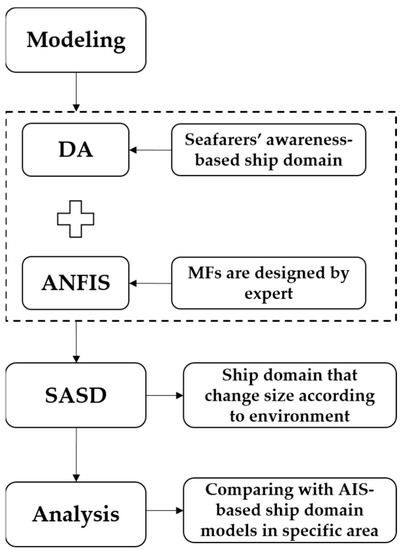
Figure 1.
Schematic diagram.
2.2. Domain Based on Awareness
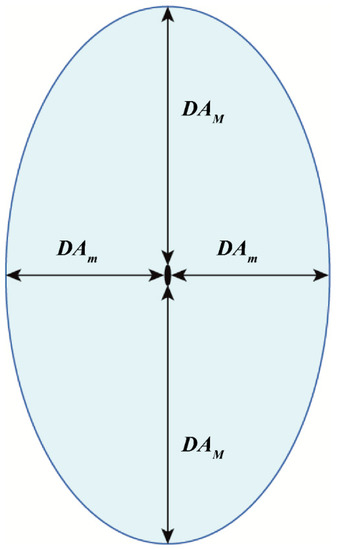
Figure 2.
Composition diagram of domain based on awareness (DA).
The presented model is represented in the elliptical domain shown in Figure 2, in which and are the major and minor axes of the ellipse, respectively. The seafarers’ awareness values were obtained as DCPA values through interviews with 123 seafarers of different ranks. The seafarers’ awareness values are represented by the DCPA threshold value (), the major axis of the presented domain model is the DCPA in a crossing situation (), and the minor axis is the DCPA in a head-on situation . Although head-on situations between two ships in restricted areas are rare, that model applied head-on () values to the minor axis of the domain for safety. However, since overtaking occurs more often in restricted areas, the DCPA in an overtaking situation () value is represented as the minor axis of the ellipse in this study. When summarizing this, the composition of this model is reflected in (1) and (2) below.
where and indicate the major and minor axes, respectively, is the rank of the seafarers such as captain, chief officer, second officer, and third officer, is average of ship’s length (240 m) i is the seafarers’ group, and j is the person in the i-th group. The term is the of the j-th person in the i-th group.
2.3. Configuration of Adaptive Neuro-Fuzzy Inference System
One of the most popular neuro-fuzzy systems is ANFIS, which is an artificial intelligence technology first presented by [38]. The ANFIS combines ANNs (with their learning ability) with fuzzy logic (capable of decision making in ambiguous situations). An ANN can process unstructured knowledge in numerical ways, and a fuzzy system can represent structural knowledge in numerical terms. Therefore, to enhance the effectiveness of artificial intelligence, ANNs and fuzzy logic must be integrated [39].
First, (3) provides a brief description of how fuzzy logic solves ambiguity:
Here is a rule, and are lingual variables, and A and B are fuzzified values. This is expressed in an implicative relation in (4), below:
where is a membership function (MF) with an implicative relation. In (5), this is represented as an MF with the operator and lingual variables of the condition and conclusion sections.
where is the operator, is the lingual variable of the condition section, and is the lingual variable of the conclusion section.
The ANFIS has the most ideal structure for problem solving via learning using ANNs [36]; however, the biggest disadvantage of ANNs is that weight values are impossible to explain. The ANFIS overcomes this disadvantage using fuzzy inference [40]. Therefore, numerous studies have applied ANFIS to the sea [41,42,43]. The structure of ANFIS is shown in Figure 3.
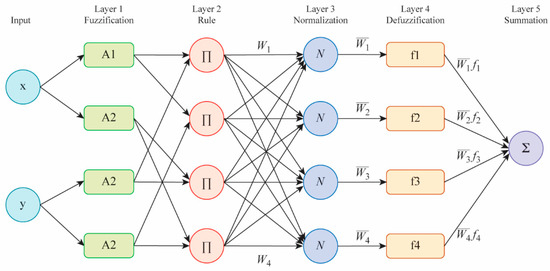
Figure 3.
Structure of the adaptive neuro-fuzzy inference system.
Figure 3 shows ANFIS configured with two inputs and one output. In the present study, it has three inputs. To easily explain the principle of the system, a figure with two inputs is selected and explained.
The characteristics of each layer in Figure 3 are as follows [36,38]. Layer 1 is known as the fuzzification layer. This layer uses an MF for obtaining fuzzy clusters from input values. This is represented below in (6) and (7):
where x is input to node i, and is a linguistic label, e.g., small, medium, or large. The term is an MF.
where are the set parameters. By changing their values, the bell-shaped functions will also be changed.
Layer 2 is a rule layer, which is represented in (8). The firing strengths () for the rules are produced by the membership values calculated in layer 1.
Layer 3 is a normalization layer, which is represented in (9). It computes the normalized firing strengths belonging to each rule. The normalized value is the ratio of the firing strength of the i-th rule to the total of all the firing strengths, as shown below in (9):
Layer 4 is a defuzzification layer, which is represented in (10). The weight values of the rules are computed in each node in this layer, as shown in (10):
where is the output of layer 3, and are the set parameters (consequence parameters).
Layer 5 is a summation layer, which is represented in (11). The actual output of the ANFIS is obtained by summing the outputs obtained for each rule in layer 4
Therefore, out of 360 input–output datasets, 70% were selected for training, 20% were selected for test, and 10% were selected for validation.
In summary, the SASD, which is presented by ANFIS based on DA, can be represented as shown by (12).
where and are the major and minor axes of the SASD, respectively, and are the resultant ANFIS values reflected to the major and minor axes, respectively.
2.4. Reflection Environmental Factors in Restricted Areas for Configuration of the ANFIS
The environmental conditions in restricted areas can affect the seafarers’ awareness value. Geographical and artificial elements in restricted areas make seafarers operate ships under various traffic conditions. Due to the various conditions in the restricted areas, the size of the ship domain should be dynamic. To reflect these dynamics, ANFIS was applied in this study.
Sailing in restricted areas is quite difficult for seafarers [44]. Thus, the operation of ships in restricted areas will require more concentration than usual. There will be several situations that will cause seafarers to have various which is the basis for the domain size.
Through the interview of three senior classes of ship’s operation, the two most important factors that influence the in the restricted area were obtained. Interviewees were 11 people who work at the site with at least 13 years of experience and have operated over 300 m of super-large ships. Additionally, they have sailing experience in various types of ships, such as bulk carriers, container carriers, and LNG (liquefied natural gas) carriers. The reason for including only the senior classes is that experienced workers show a higher level of situation awareness [45]. So, groups of three senior classes of ship’s operation are used to create a fuzzy logic reflecting various perspectives on the unanswered conclusions.
The groups comprised chief officers (those who have worked for more than 13 years), captains, and a pilot.
The results of the interview on the two factors that most affect the in restricted area are shown in Table 1.

Table 1.
Important factors that affect when passing through restricted area.
The first most important factor is volume of traffic. The varies depending on how many ships there are around an own ship. Generally, the standard of distance around the OS is less than five miles, taking into account the radar range used by seafarers during passing restricted area.
The second most important factor is the width of a channel. They said that varies depending on the channel width. Because if there is little space for avoiding TS, action to avoid collisions should be taken in advance to avoid dangerous situations.
Considering the first factor, if there are many ships around the OS only a small space is available for free navigation. Furthermore, the second factor affects navigable space. Alternatively, the factors that invade navigable space affect the most.
To consider all the factors discussed by the expert group in the modeling of the ship domain, this study attempted to reflect an additional factor. To consider a factor as ETC such as TS size, current, fishing boat, and irregular situation besides the two most frequently presented ones above, three input MFs were constructed, as shown in (13).
where indicates the output of ANFIS, is the input variable width of the restricted area, presents the input variable volume of traffic, and represents the input variable of ETC.
As shown in Figure 4 below, the range of each MF was set following discussions with the expert groups.
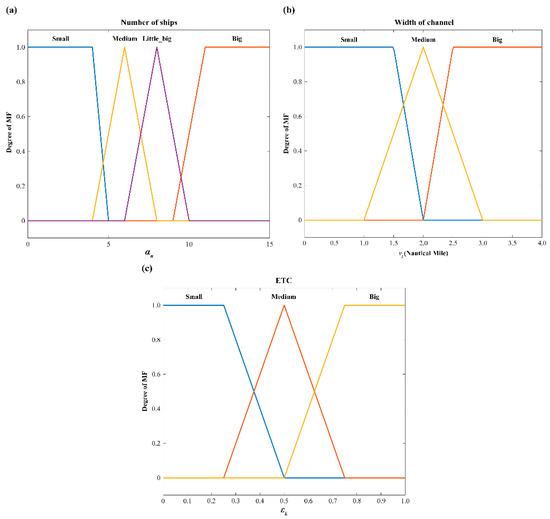
Figure 4.
Inputs of the membership function (MF).
ETC’s MF was designed with reference to Table 2 below considering current, the number of fishing boats, and size of TS.

Table 2.
ETC’s MF configuration.
3. Results
3.1. Training Results
The results of training with ANFIS (as described in Section 2) and implementation via [46] are shown in Table 3 below. The values in the table became dimensionless.

Table 3.
Training results error.
Table 3 shows error values of train, test, and validation. Here, L means the overall length of the ship (240 m). As shown in Table 3, the values of validation are small between about 19 m in head-on situation and 43 m in crossing situation when converted to meters. The best performance for validation was shown for epoch 30. Even after training for more than 30 epochs, there was rarely a decrease in the error values anymore.
The reason why the error in the crossing situation is greater than in the overtaking situation is that the deviation of the variation in the value is greater than the . Based on the values presented with the ANFIS, we schematized the SASD as follows.
3.2. Seafarers’ Awareness-Based Ship Domain
The SASD to which the ANFIS is applied can be expressed as a dynamic domain representing the maximum and minimum sizes, as shown in Figure 5. The SASD with ANFIS applied to the existing DA domain model [29] in the method described in Section 2 is a dynamic domain whose size changes depending on the number of ships around the OS, the width of the restricted area, and other variables.

Figure 5.
Maximum/minimum sizes of seafarers’ awareness−based ship domain.
In Figure 5, the horizontal and vertical axes are expressed as dimensionless values obtained by dividing the X and Y axes by the average length of the ship (240 m) based on [29]. The red ellipse represents the largest SASD, while the blue ellipse represents the smallest SASD. At its maximum size, the major axis is 8.1 L, and the minor axis is 3.5 L. In the blue ellipse, these values are 5.2 L and 2.7 L, respectively.
Next, the SASD will be compared with the existing ship domain models for restricted areas.
3.3. Comparing Ship Domain Models in a Restricted Area
Figure 6 shows a comparison of SASDs between existing ship domain models in restricted areas based on ship traffic data. The two types of dotted black ellipse indicate the largest and smallest SASDs, the green ellipse represents the model in [11], the pink ellipse is the model presented by [22], and the blue ellipse represents the model in [24].
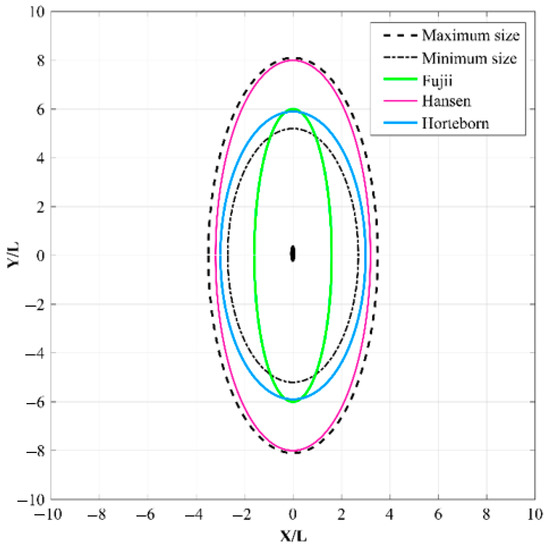
Figure 6.
Maximum/minimum sizes of seafarers’ awareness−based ship domain.
The information on the length of the channels and the ships as used in the studies represented in the domain comparison is as follows:
The model in [11] is a domain model based on data that measured navigating ships with radar. Comparing the maritime transportation environment of the Fujii model to the present day, the larger size of modern ships should be considered. In addition, the density of marine traffic should be considered since marine traffic has increased in the intervening period.
For the Hansen model, an average ship length of 110 m was applied on a 300 m wide channel [22]. Therefore, it is necessary to consider that the average ship length (240 m) of the DA applied in this study is short. Additionally, Hansen’s model is a ship domain based on AIS data in waters where overtaking is almost impossible due to the channel’s width.
The model of [24] reflects various restricted areas. However, it should be considered that the model is designed based on a location where the volume of ship traffic is lower than at the application location in this study.
Comparing the above models in terms of SASD, since the design methods of this domain and the target areas are different, we believe it will be difficult to define the optimum model using only the presented Figure 6. However, some ship domain models are somewhat similar in size. For a more accurate comparative analysis, we analyzed the appearance of the SASD when applied to actual restricted areas.
3.4. Application to Restricted Areas
3.4.1. Applying the SASD to Restricted Waters
To confirm practicality when applying the SASD to restricted areas, two areas were selected with heavy shipping traffic from different parts of the world: the Singapore Strait and the Dover Strait. The reason for this was that ships sailing in the Singapore Strait most frequently encounter overtaking/overtaken situations. However, the frequency of crossing situation is not significant in the Singapore Strait. Therefore, as a result of the real-time monitoring of the Dover Strait and the Gibraltar Strait, both of which happen multiple crossing situations, the Dover Strait was used due to its higher number of crossing situations.
Figure 7 shows the monitoring results of the two straits for the application of the SASD. The real-time navigation of ships in the Singapore and Dover straits is based on AIS data from [47] as shown in Figure 7. We monitored the two traffic separation schemes (TSSs) using this web page.
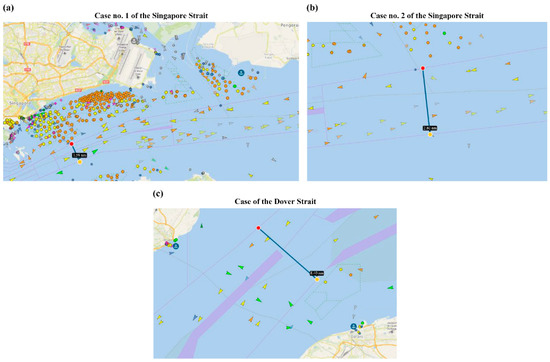
Figure 7.
Traffic separation scheme for applying the domain model.
Figure 7a,b shows the Singapore Strait, with its strait width of 1.6 or 2.8 NM. In the Singapore Strait, three to four ships are often on the same route, leading to several overtaking/overtaken situations. Figure 7c shows the Dover Strait; although the passage is wider than the Singapore Strait, several crossing situations are also observed in the Dover Strait. Four ships crossing the strait in Figure 7c.
Assuming that the OS in Figure 7 is eastbound, the widths, ship traffic volume, and ETC in these three cases were applied. The results were compared with the existing AIS-based domain models given and are presented in Figure 8.
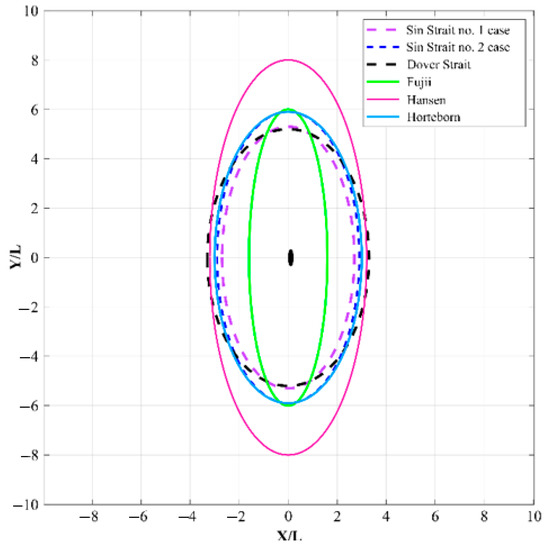
Figure 8.
Seafarers’ awareness−based ship domains of other models in different waters.
Figure 8 compares the SASD applied to the restricted areas with other domain models applicable to restricted areas. The dotted purple ellipse is the SASD depicted in Figure 7a, the dotted blue ellipse is the SASD in Figure 7b, and the dotted black ellipse is the SASD in Figure 7c. The green ellipse is the model of [11], the pink ellipse is the model of [22], and the sky-blue ellipse is the model of [24]. Since the latter showed the domain size in nautical miles without providing the average ship length, we nondimensionalized it under the assumption that it was the same as the average ship length (240 m) in this study, and the SASD was compared.
In all three cases, the SASD was a similar size, although that in Figure 7b was the largest. It may be expected that the major axis of the ellipse would appear large because of the presence of many crossing ships in the Dover Strait; however, it was small due to the wide width of the passage. In the case of Figure 7a, the domain became smaller because the passage width was the narrowest, and two ships were overtaken.
In the Singapore Strait, some of the passages are 1.6 NM or less in width. This means that westbound and eastbound ships must sail in a passage that is 0.8 NM or less wide. The length of the vessel boarded by one of the authors was about 280 m, and the minor axis of the ellipse of the SASD in the dotted purple line was 2.7 L (Figure 8). When calculated in NMs (using a 280 m ship), this represents about 0.4 NM. Then, if three ships simultaneously sail side by side based on the SASD model, the TS may invade on the SASD. However, this does not mean that this model is wrong or impractical. This is because the distance of SASD is large to avoid TS, but it is a safe distance of seafarers’ awareness to be cautious of TS. Realistically, SASD could be reduced more. Therefore, we may consider that it can be established as small as in the other two models.
In the case of the major axis of the ellipse, its size with the Hansen model is somewhat different from the other models. There is a difference of 2 L, which is equivalent to about 0.3 NM. This difference may be due to the differences in both the domain design method and the applied areas and requires further analysis.
Although different from the Hörteborn model in terms of SASD methodology, the two models showed similar trends. Differences may exist between studies based on multiple ships’ traffic data in restricted areas and domains based on seafarers’ awareness. This is because AIS data may not contain the intentions of the seafarers. Conversely, this is contained in the SASD. In summary, even if seafarers have an intention, they may still sail while unable to maintain the desired safe distance due to the surrounding conditions. The AIS data-based ship domain model includes this element. Since the AIS data can have a deviation, it may be a trend distance for ships to sail in the corresponding areas. Of course, a simple comparison may be difficult because Hörteborn’s model, when applied to restricted areas, differs from this study. However, considering the similarity between the SASD and Hörteborn’s models, the domain size has few changes depending on the restricted areas.
3.4.2. Comparison with the Model of Applied to Specific Waters
Figure 9 shows the SASD applied to two of the areas studied by Hörteborn (Figure 10). In Figure 10a,b, the dotted blue ellipse is Hörteborn’s model, and the black ellipse is the SASD.

Figure 9.
Seafarers’ awareness−based ship domains of other models in different waters.
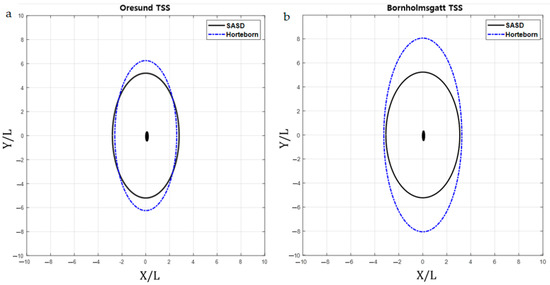
Figure 10.
Comparison of domain models in two waters (a) Oresund TSS, (b) Bornholmsgatt TSS.
Figure 9 indicates that the traffic volume in the two areas is not as high as in the Singapore or Dover straits. Moreover, the sea passage in Figure 9b is relatively wide, and a crossing situation rarely occurs along these two sea routes.
The minor axes of the ellipses in the two models are similar, although there is a little difference between the major axes. After analyzing this, we consider that the differences are due to the aforementioned domain design method. In SASD model, even if the TS is located in front of the OS in an overtaking situation, the distance at that moment is not reflected in the domain design. In the overtaking situation, before the OS overtakes the TS, even if the TS is located in front of the OS, then that distance is not reflected in the SASD configuration. Only the distance at which the two ships in the overtaking situation pass closest to each other on the lateral sides are included in the minor axis of SASD. So, the major axis is somewhat different and the minor axis is analyzed as similar between the two models. Conversely, regarding the length of the major axis, we consider that the SASD should be supplemented in the future. However, it could be seen that overtaking/overtaken, which occur most frequently in restricted areas, appeared to be similar in the awareness-based and AIS-based domains.
4. Discussion
In this study, it has been concluded that the major axis of the ellipse should increase as the risk increases during a crossing situation, although the ellipse’s minor axis was slightly different. In a crossing situation, avoiding a TS at a close distance in restricted areas requires changing the large heading angle, which may be risky, for which experts recommend taking preemptive action.
However, in terms of the overtaking situation, due to the nature of navigating restricted areas, the experts stated that if it were unavoidable, passage that rarely occurs may be permitted at a close distance to the TS. In their experience, there is no navigational risk due to the hull–hull interaction between the two ships, even when an OS over 300 m in length passes a TS at a DCPA of about 0.2 to 0.3 miles. One pilot, who performs fine maneuvering ships, even claimed that there is no significant risk in passing the lateral side of the TS up to 0.2 miles. Accordingly, the authors set the length of the minor axis of the ellipse representing the domain size to be smaller under an overtaking/overtaken situation to enable the OS to pass in restricted areas, even in the presence of many ships.
It could be disputed from a safety perspective that, considering the width of the restricted areas and the traffic volume, creating a large domain may cause a dangerous situation because of the substantial change in heading angle. If a MASS suddenly changes their heading angle among ships sailing side by side behind a TS, it may be difficult for the TSs to understand the intention of the MASS. In addition, this can cause an unexpected situation and create an additional risk to other TSs.
Therefore, if the minimum safe distance is given, the domain should be designed with consideration of various parameters to enable the MASS to sail in restricted areas.
Although this study presented a novel ship domain model, it also has limitations. The seafarers’ awareness values do not change precisely depending on the angle of the ship’s encounter. For example, in a crossing situation, even though the encountering angles were different, seafarers did not have different awareness values. This part should be fused with the engineering-based ship domain model and supplemented later.
5. Conclusions
The purpose of this study was to quantify the awareness values of seafarers’ safe distance in restricted areas and apply them to MASS. We intended to present the criteria for the safe distance of MASS by identifying how seafarers interpret and quantitatively represent the COLREGS. Therefore, we expressed the criteria in domain form using seafarers’ awareness values and ANFIS. We presented improved domain models suitable for encountering situations by identifying factors that influence seafarers’ awareness.
The proposed model, which was designed differently from existing domains, has shown the reality of seafarer’ awareness in more detail than previous studies. This study did not consider that it was necessarily dangerous to have less navigable area due to more TS and narrow width of channel in overtaking/overtaken situations. Therefore, a smaller ship domain was designed for smaller navigable areas that occur most frequently in restricted areas; threshold values of safe distance in overtaking/overtaken situation were also presented.
When deciding to pass closer to a TS or make a change course, seafarers opted mainly to pass close to the TS, even if it was a little dangerous. This is because they thought that situations that could occur due to changing heading angles in restricted areas were dangerous and difficult to predict what would happen.
The OS must substantially change the heading angle to avoid the TS in a crossing situation. However, since a large-angled changing course is difficult in restricted areas, the major axis of the SASD is designed to increase with the risk.
When the AIS data-based domains were compared with the SASD, the lateral side passing distance between two ships was somewhat similar. The authors consider this to be a proven distance that can be referenced for navigating MASS in restricted areas to some extent. However, in the case of the major axis of the ellipse, it is clear that additional research is needed.
Navigation in restricted areas is more difficult than that in the open sea [44]. We conducted this study to quantify the values of seafarers’ awareness of the safe distance specifically in difficult restricted areas. This study presented dynamic safe distance which can be criteria for collision avoidance based on seafarers’ awareness in restricted areas. The major axis of SASD should be needed to be supplemented, and further study is required to identify and address in detail the additional factors affecting the seafarers’ awareness values in restricted areas to enable the navigation of MASS.
Author Contributions
Conceptualization, H.-J.L.; methodology, H.-J.L. and D.-J.P.; data curation, H.-J.L.; software, H.-J.L.; visualization, H.-J.L.; investigation, H.-J.L.; writing—original draft preparation, H.-J.L.; validation, D.-J.P.; supervision, D.-J.P.; writing—reviewing and editing, D.-J.P.; funding, D.-J.P. All authors have read and agreed to the published version of the manuscript.
Funding
This work was supported by the National Research Foundation of Korea (NRF) grant funded by the Korean Government (MSIT) (No.2022R1F1A1070331).
Institutional Review Board Statement
Not applicable.
Informed Consent Statement
Not applicable.
Data Availability Statement
Not applicable.
Conflicts of Interest
The authors declare that they have no known competing financial interests or personal relationships that could have appeared to influence the work reported in this paper.
References
- IBM. Mayflower Autonomous Ship Project. 2020. Available online: https://newsroom.ibm.com/2020-03-05-Sea-Trials-Begin-for-Mayflower-Autonomous-Ships-AI-Captain (accessed on 10 June 2021).
- Zaccone, R.; Martelli, M.; Figari, M. A Colreg-Compliant Ship Collision Avoidance Algorithm. In Proceedings of the 2019 18th European Control Conference (ECC), Naples, Italy, 25–28 June 2019; IEEE: Piscataway, NJ, USA, 2019; pp. 2530–2535. [Google Scholar]
- Miyoshi, T.; Fujimoto, S.; Rooks, M.; Konishi, T.; Suzuki, R. Rules required for operating maritime autonomous surface ships from the viewpoint of seafarers. J. Navig. 2022, 75, 384–399. [Google Scholar] [CrossRef]
- Allianz Global Corporate & Speciality. Safety and Shipping Review; Allianz: Munich, Germany, 2021. [Google Scholar]
- EMSA. Annual Overview of Marine Casualties and Incidents 2020; EMSA: Lisbon, Portugal, 2020. [Google Scholar]
- Yim, J.B.; Park, D.J. Estimating Critical Latency Affecting Ship’s Collision in Re-Mote Maneuvering of Autonomous Ships. Appl. Sci. 2021, 11, 10987. [Google Scholar] [CrossRef]
- Gil, M.; Kozioł, P.; Wróbel, K.; Montewka, J. Know your safety indicator–A determination of merchant vessels Bow Crossing Range based on big data analytics. Reliab. Eng. Syst. Saf. 2022, 220, 108311. [Google Scholar] [CrossRef]
- Li, L.; Wu, D.; Huang, Y.; Yuan, Z.M. A path planning strategy unified with a COLREGS collision avoidance function based on deep reinforcement learning and artificial potential field. Appl. Ocean Res. 2021, 113, 102759. [Google Scholar] [CrossRef]
- Vestre, A.; Bakdi, A.; Vanem, E.; Engelhardtsen, Ø. AIS-based near-collision database generation and analysis of real collision avoidance manoeuvres. J. Navig. 2021, 74, 985–1008. [Google Scholar] [CrossRef]
- Szlapczynski, R.; Szlapczynska, J. A ship domain-based model of collision risk for near-miss detection and Collision Alert Systems. Reliab. Eng. Syst. Saf. 2021, 214, 107766. [Google Scholar] [CrossRef]
- Fujii, Y.; Tanaka, K. Traffic capacity. J. Navig. 1971, 24, 543–552. [Google Scholar] [CrossRef]
- Coldwell, T.G. Marine traffic behaviour in restricted waters. J. Navig. 1983, 36, 430–444. [Google Scholar] [CrossRef]
- Davis, P.V.; Dove, M.J.; Stockel, C.T. A computer simulation of multi-ship encounters. J. Navig. 1982, 35, 347–352. [Google Scholar] [CrossRef]
- Goodwin, E.M. A statistical study of ship domains. J. Navig. 1975, 28, 328–344. [Google Scholar] [CrossRef] [Green Version]
- Rawson, A.; Rogers, E.; Foster, D.; Phillips, D. Practical application of domain analysis: Port of London case study. J. Navig. 2014, 67, 193–209. [Google Scholar] [CrossRef]
- Szlapczynski, R.; Krata, P.; Szlapczynska, J. Ship domain applied to determining distances for collision avoidance manoeuvres in give-way situations. Ocean Eng. 2018, 165, 43–54. [Google Scholar] [CrossRef]
- Yim, J.B.; Park, D.J. Modelling Evasive Actions to Be Implemented at the Minimum Distance for Collision Avoidance in a Give-Way Situation. Ocean Eng. 2022; underwork. [Google Scholar]
- Bakdi, A.; Vanem, E. Fullest COLREGs Evaluation Using Fuzzy Logic for Collaborative Decision-Making Analysis of Autonomous Ships in Complex Situations. IEEE Trans. Intell. Trans. Syst. 2022, 1–13. [Google Scholar] [CrossRef]
- Szlapczynski, R.; Szlapczynska, J. Review of ship safety domains: Models and applications. Ocean Eng. 2017, 145, 277–289. [Google Scholar] [CrossRef]
- Wang, Y.; Chin, H.C. An empirically-calibrated ship domain as a safety criterion for navigation in confined waters. J. Navig. 2016, 69, 257–276. [Google Scholar] [CrossRef] [Green Version]
- Gucma, L.; Marcjan, K. Examination of ships passing distances distribution in the coastal waters in order to build a ship probabilistic domain. Zesz. Nauk./Akad. Morska W Szczec. 2012, 32, 34–40. [Google Scholar]
- Hansen, M.G.; Jensen, T.K.; Lehn-Schiøler, T.; Melchild, K.; Rasmussen, F.M.; Ennemark, F. Empirical ship domain based on AIS data. J. Navig. 2013, 66, 931–940. [Google Scholar] [CrossRef] [Green Version]
- Iperen, W.H. Classifying ship encounters to monitor traffic safety on the North Sea from AIS data. TransNav Int. J. Mar. Navig. Saf. Sea Trans. 2015, 9, 51–58. [Google Scholar] [CrossRef] [Green Version]
- Hörteborn, A.; Ringsberg, J.W.; Svanberg, M.; Holm, H. A revisit of the definition of the ship domain based on AIS analysis. J. Navig. 2019, 72, 777–794. [Google Scholar] [CrossRef]
- Kijima, K.; Furukawa, Y. Automatic collision avoidance system using the concept of blocking area. IFAC Proc. Vol. 2003, 36, 223–228. [Google Scholar] [CrossRef]
- Liu, J.; Zhou, F.; Li, Z.; Wang, M.; Liu, R.W. Dynamic ship domain models for capacity analysis of restricted water channels. J. Navig. 2016, 69, 481–503. [Google Scholar] [CrossRef] [Green Version]
- Wang, N. A novel analytical framework for dynamic quaternion ship domains. J. Navig. 2013, 66, 265–281. [Google Scholar] [CrossRef] [Green Version]
- Jingsong, Z.; Zhaolin, W.; Fengchen, W. Comments on ship domains. J. Navig. 1993, 46, 422–436. [Google Scholar] [CrossRef]
- Lee, H.J.; Furukawa, Y.; Park, D.J. Seafarers’ awareness-based domain modelling in restricted areas. J. Navig. 2021, 74, 1172–1188. [Google Scholar] [CrossRef]
- Hsu, F.H. IBM’s deep blue chess grandmaster chips. IEEE Micro 1999, 19, 70–81. [Google Scholar]
- Wang, F.Y.; Zhang, J.J.; Zheng, X.; Wang, X.; Yuan, Y.; Dai, X.; Yang, L. Where does AlphaGo go: From church-turing thesis to AlphaGo thesis and beyond. IEEE/CAA J. Automat. Sin. 2016, 3, 113–120. [Google Scholar]
- Qiao, Z.; Zhang, Y.; Wang, S. A Collision Risk Identification Method for Autonomous Ships Based on Field Theory. IEEE Access 2021, 9, 30539–30550. [Google Scholar] [CrossRef]
- Karaboga, D.; Kaya, E. Adaptive network based fuzzy inference system (ANFIS) training approaches: A comprehensive survey. Artif. Intell. Rev. 2019, 52, 2263–2293. [Google Scholar] [CrossRef]
- Ali, M.; Ghatol, A. A Neuro-Fuzzy Inference System for Student Modeling in Web-Based Intelligent Tutoring Systems. In Proceedings of the International Conference on Cognitive Systems, Victoria, BC, Canada, 11 December 2004. [Google Scholar]
- Kurnaz, S.; Cetin, O.; Kaynak, O. Adaptive neuro-fuzzy inference system based autonomous flight control of unmanned air vehicles. Expert Syst. Appl. 2010, 37, 1229–1234. [Google Scholar] [CrossRef]
- Karaboğa, D.; Kaya, E. Evaluation of Performance of Adaptive and Hybrid abc (aabc) Algorithm in Solution of Numerical Optimization Problems. In Proceedings of the Intelligent Systems and Applications Conference (ASYU), Adana, Turkey, 4–6 October 2018; IEEE: Piscataway, NJ, USA, 2018; pp. 1–5. [Google Scholar]
- Zadeh, L.A. Fuzzy logic. Scholarpedia 2008, 3, 1766. [Google Scholar] [CrossRef]
- Jang, J.S. ANFIS: Adaptive-network-based fuzzy inference system. IEEE Trans. Syst. Man Cybern. 1993, 23, 665–685. [Google Scholar] [CrossRef]
- Kosko, B. Fuzzy Associative Memory Systems. In Fuzzy Expert Systems; CRC Press: Boca Raton, FL, USA, 1992; pp. 135–162. [Google Scholar]
- Kar, S.; Das, S.; Ghosh, P.K. Applications of neuro fuzzy systems: A brief review and future outline. Appl. Soft Comput. 2014, 15, 243–259. [Google Scholar] [CrossRef]
- Ahn, J.H.; Rhee, K.P.; You, Y.J. A study on the collision avoidance of a ship using neural networks and fuzzy logic. Appl. Ocean Res. 2012, 37, 162–173. [Google Scholar] [CrossRef]
- Sedova, N.A.; Sedov, V.A.; Bazhenov, R.I. The neural-fuzzy approach as a way of preventing a maritime vessel accident in a heavy traffic zone. Adv. Fuzzy Syst. 2018, 2018, 2367096. [Google Scholar] [CrossRef] [Green Version]
- Namgung, H.; Kim, J.S. Collision risk inference system for maritime autonomous surface ships using COLREGs rules compliant collision avoidance. IEEE Access 2021, 9, 7823–7835. [Google Scholar] [CrossRef]
- Inoue, K. Evaluation method of ship-handling difficulty for navigation in restricted and congested waterways. J. Navig. 2000, 53, 167–180. [Google Scholar] [CrossRef]
- Endsley, M.R. Design and evaluation for situation awareness enhancement. Proc. Hum. 1988, 32, 97–101. [Google Scholar] [CrossRef]
- MATLAB. MATLAB and Statistical Toolbox; Release 2021a; Math Works Inc.: Natick, MA, USA, 2021. [Google Scholar]
- Vesselfinder. 2022. Available online: http://www.vesselfinder.com (accessed on 10 June 2021).
Publisher’s Note: MDPI stays neutral with regard to jurisdictional claims in published maps and institutional affiliations. |
© 2022 by the authors. Licensee MDPI, Basel, Switzerland. This article is an open access article distributed under the terms and conditions of the Creative Commons Attribution (CC BY) license (https://creativecommons.org/licenses/by/4.0/).